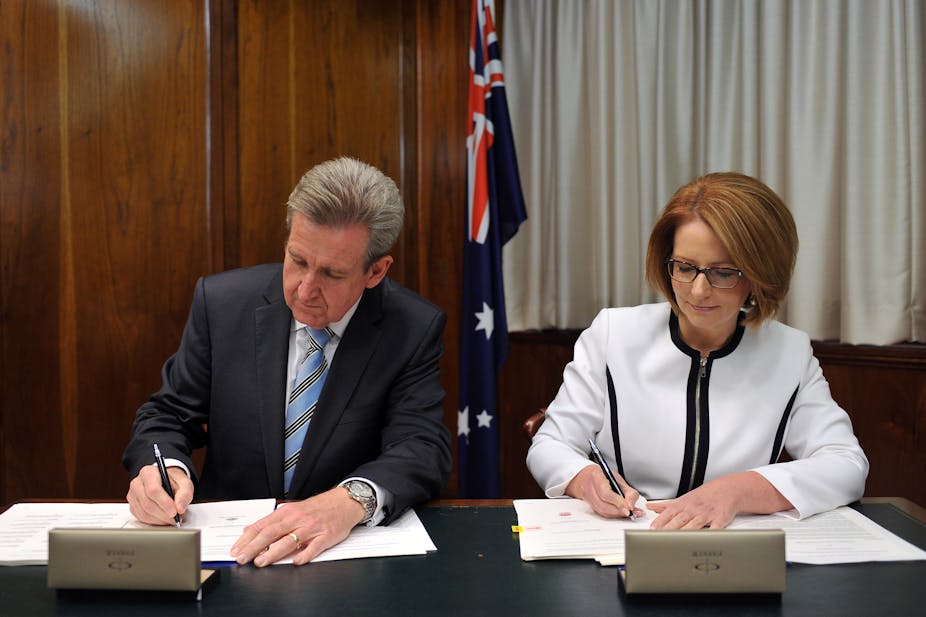Australian Prime Minister Julia Gillard today said NSW has become the first state to sign up to the National Education Reform Agreement, which aims to add $A14.5 billion to the public and private school sector over six years.
The announcement, made today at joint press conference with NSW Premier Barry O'Farrell, comes after weeks of wrangling over a suite of education policy changes proposed by the Federal Government following the Gonski review of school funding.
No state signed up to the proposals when they were put forward at the Council of Australian Government (COAG) meeting last Friday.
But under the agreement made today, NSW will pitch in $1.76 billion and the Federal Government will provide $3.27 billion, meaning an extra $5 billion for NSW schools over six years.
Today’s development will provide a significant boost to Ms Gillard, who has pushed the plan hard in the lead up to the 2013 federal election.
‘Historic announcement’
The Federal Government has proposed stripping A$2.3 billion from universities to pay for new school funding and introducing a $900 million efficiency dividend that will result in a 2% reduction in university funding in 2014 and a 1.25% in 2015.
For their part, the states have been asked to provide a third of the money needed to fund the Federal Government’s plan.
The Northern Territory and Western Australia have resisted backing Ms Gillard’s reforms.
NSW’s support for the Gonski plan is significant because it is the biggest state and controlled by Ms Gillard’s political foes, the Coalition.
“This is an historic announcement, not only for NSW education but for Australian education,” Ms Gillard said at today’s press event in Sydney.
“For me, this is the culmination of five years of work in government.”
Mr O'Farrell said he was pleased NSW was the first Australian state to back to the plan.
“We are delighted today to sign up to this agreement because it provides additional resources, fairer distribution to deliver high standards and better outcomes for schools across NSW,” he said.
“The NSW government has said since the Gonski report was released that we supported the thrust of its recommendations.”
A statement released by Ms Gillard’s office said the Federal Government “has committed to grow its school education spending by 4.7% per year from 2014 into 2015 and throughout the agreement. In return, NSW has agreed to grow its own school budget by 3% per year from 2016 onwards.”
Additional momentum
Bronwyn Hinz, from the University of Melbourne’s School of Social and Political Sciences and the Melbourne Graduate School of Education said she was enthused by today’s developments.
“I was feeling very optimistic after COAG and I expected all or most states to sign up to the proposed school funding reforms. I didn’t expect it to happen so quickly. I think this will create additional momentum for other states to sign up. No state want to be the one getting the crumbs at the end,” she said.
“Even the Northern Territory, which has been described in the News Ltd press as being hostile, said they are leaving the door open. All states, behind the scenes, are looking over the fine print and at their budgets.”
Dr Carmen Lawrence, director of the University of Melbourne’s Centre for the Study of Social Change and a former Gonski review panel member, said a deal should have been struck sooner.
“Doing the [negotiations] in the shadow of an election was always going to make it harder,” she said.
“I’m very pleased that this agreement, this first step, has been made towards needs-based funding which is essentially what was proposed [under the Gonski review]. It’s a recognition of the growing gap between the highest and lowest performers, based on income and disadvantage. This was something that simply couldn’t be sustained and shouldn’t be, for reasons of common decency.”
Should the Coalition win the federal election, there remains a chance it may repeal an agreement but Dr Lawrence said “it would be a brave federal government who would say to the NSW government, ‘Oh by the way, we’re going to take $3.27 billion out of your budget’.”
Dr Lawrence said the Commonwealth must better explain and negotiate their plan if they want agreement from states like Western Australia.
“It would also help if the Premier rolled up his sleeves and got engaged in the negotiations,” she said.
“The disappointing fact remains that some of those funds are being taken out of the universities… so the source of these funds is not a happy one.”
Jim McMorrow, Honorary Associate Professor at University of Sydney’s Faculty of Education and Social Work, said the agreement “signals a potential break-through in rectifying the structural imbalance in federal and state funding responsibilities for schools.”
“As acknowledged by the NSW Premier, this has significant benefits for the state’s public schools, which have been adversely affected by the Commonwealth’s current funding arrangements,” he said.
“What is now needed is federal legislation that secures the fine detail of the new funding arrangements, including new funding principles, the national resource standards, criteria for assessing schools’ needs, indexation mechanisms and the provision for ongoing review.”

